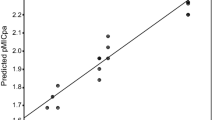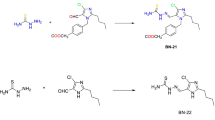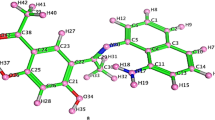Abstract
The aim of this work was to investigate the antibacterial and antifungal activities of novel d-amino acid-Schiff bases including fluorine atom and their Cr(III) and Ni(II) complexes. All these substances have been examined for antibacterial activity against pathogenic strains Listeria monocytogenes 4b ATCC19115, Staphylococcus aureus ATCC25923, Escherichia coli ATCC1280, Salmonella typhi H NCTC 901.8394, Brucella abortus (A.99, UK-1995) RSKK03026, Staphylococcus epidermis sp., Micrococus luteus ATCC9341, and Shigella dysenteria typ 10 NCTC 9351, and antifungal activity against Candida albicans Y-1200-NIH, Tokyo. The antimicrobial test results of these amino acid-Schiff base complexes exhibited better activity than some known antibiotics. In particular, diamagnetic Ni(II) complexes were more potent bactericides than all of the substances synthesized.



Similar content being viewed by others
References
Abram U, Alberto R (2006) Technetium and rhenium: coordination chemistry and nuclear medical applications. J Braz Chem Soc 17:1486–1500
Altundas A, Sarı N, Colak N, Ögütcü H (2010) Synthesis and biological activity of new cycloalkylthiophene-Schiff bases and their Cr(III) and Zn(II) complexes. Med Chem Res 19:576–588
Avaji PG, Patil SA, Badami S (2008) Synthesis, spectral, thermal, solid-state DC electrical conductivity and biological studies of Co(II) complexes with Schiff bases derived from 3-substituted-4-amino-5-hydrazino-1,2,4-triazole and substituted salicylaldehydes. Trans Met Chem (Weinh). 33:275–283
Eglof R, Piotr P, Bogumil B, Franz B (2009) Schiff bases in biological systems. Curr Org Chem 13:241–249
Ellis G, Chang L, Cogionis B, Daneman D (1997) Incomplete removal of labile fraction when measuring hemoglobin A1c with bio-rad variant analyzer. Clin Chem 43:2437–2439
Gharagozlou M, Boghaei DM (2008) Interaction of water-soluble amino acid Schiff base complexes with bovine serum albumin: fluorescence and circular dichroism studies. Spectrochim Acta Mol Biomol Spectros 71:1617–1622
Murukan B, Mohanan K (2007) Synthesis, characterization and antibacterial properties of some trivalent metal complexes with [(2-hydroxy-1-naphthaldehyde)-3-isatin] bishydrazone. J Enzym Inhib Med Chem 22:65–70
Negm NA, Zaki MF (2009) Synthesis and characterization of some amino acid derived Schiff bases bearing nonionic species as corrosion inhibitors for carbon steel in 2N HCl. J Disper Sci Technol 30:649–655
Sakıyan I, Loğoğlu E, Sari N, Sakıyan N (2004) Antimicrobial activities of N-(2-hydroxy-1-naphthalidene)-aminoacid(glycine, alanine, phenylalanine, histidine, tryptophane) Schiff bases and their manganese(III) complexes. Biometals 17:115–120
Sarı N, Gürkan P (2004) Some novel amino acid-Schiff bases and their complexes synthesis, characterization, solid state conductivity behaviors and potentiometric studies. Z Naturforsch B 59(6):692–698
Sari N, Gürkan P, Cete S, Sakiyan I (2006) Synthesis, potentiometric and antimicrobial activity studies on DL-Amino Acids-Schiff Bases and their complexes Russ. J Coord Chem 32(7):511–517
Sarı N, Gürkan P, Arslan S (2003) Synthesis, potentiometric and antimicrobial activity studies on 2-pyridinilidene-DL-amino acids and their complexes. Trans Met Chem 28:468–474
Sarı N, Nartop D, Karcı F, Disli A (2008) Novel hydrazone derivatives and their tetracoordinated metal complexes. Asian J Chem 20:1975–1985
Silverstein RM, Bassler GC, Morrill TC (1981) Spectrophotometric identification of organic compounds, 4th edn. Wiley, New York, pp 125–130
Singh K, Singh DP, Barwa MS, Tyagi P, Mırza Y (2006) Antibacterial Co(II), Ni(II), Cu(II) and Zn(II) complexes of Schiff bases derived from fluorobenzaldehyde and triazoles. J Enzym Inhib Med Chem 21:557–562
Takeuchi T, Böttcher A, Quezada CM, Meade TJ, Gray HB (1999) Inhibition of thermolysin and human α-thrombin by cobalt(III) Schiff base complexes. Bioorg Med Chem 5:815–819
Wang MZ, Meng ZX, Liu BL, Cai GL, Zhang CL, Wang XY (2005) Novel tumor chemotherapeutic agents and tumor radio-imaging agents: potential tumor pharmaceuticals of ternary copper(II) complexes. Inorg Chem Commun 8:368–371
Wang RM, Mao JJ, Song JF, Huo CX, He YF (2007) Antioxidant activity of bovine serum albumin binding amino acid Schiff-bases metal complexes. Chinese Chem Lett 18:1416–1418
Acknowledgments
This work was supported by the Gazi University Research Fund (Project number: 05/2010-03 and 05/2007-02).
Author information
Authors and Affiliations
Corresponding author
Rights and permissions
About this article
Cite this article
Sarı, N., Pişkin, N., Öğütcü, H. et al. Spectroscopic characterization of novel d-amino acid-Schiff bases and their Cr(III) and Ni(II) complexes as antimicrobial agents. Med Chem Res 22, 580–587 (2013). https://doi.org/10.1007/s00044-012-0039-5
Received:
Accepted:
Published:
Issue Date:
DOI: https://doi.org/10.1007/s00044-012-0039-5




